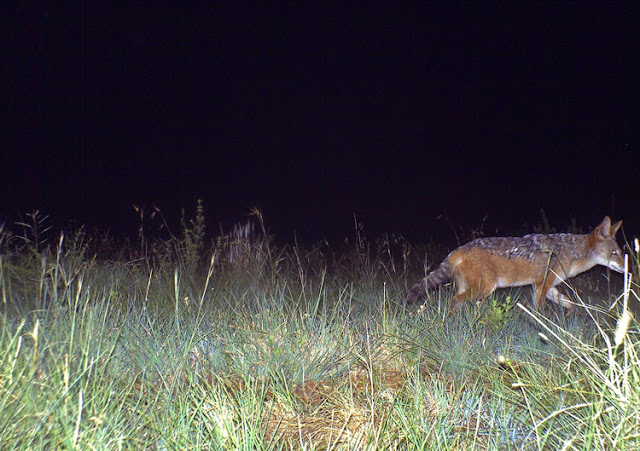Cropping can have a huge effect on your photographs. It can either make or break a photograph. I have to admit that I'm definitely not an expert at cropping or framing pictures. Still, I don't let that prevent me from at least trying to find a good crop for the photos I upload to this blog.
Form my (limited) experience the following concepts come to mind when I think about cropping a camera trap photo:
- What aspect ration will work best?
- Will landscape or portrait work best?
- What should be the focus point of the image?
- How large do I want the animal to be in the final crop?
- How should I crop the photo to "tell a story"?
- What are the limiting factor? (For example resolution, border, obstructions, etc.)
There is a bit of a love hate relationship between cropping and camera trapping. On the one hand you have very little control over the final image, especially where the animal will be in the photograph, as a result the initial (original) crop is usually rather bad. On the other hand you can use cropping to try and alleviate this problem by making a smaller but better crop of the original image.
However in some situations no amount of cropping can save the image...
 |
| [Original] Steenbok (Steenbok - Raphicerus campestris) at Koeberg Nature Reserve |
Sometimes a little cropping can still make a meaningful improvement. For example, even thought the full animal isn't in the crop you might still be able to do the background scenery more justice with a good crop.
With some photographs the animal is simply too far away. In these situations cropping can be a very useful tool to bring the photograph to life.
 |
| [Original] Caracal (Rooikat - Caracal caracal) at Koeberg Nature Reserve |
 |
| This slightly closer landscape crop still contains the essence of the original image |
 |
| I think this much closer landscape crop starts to lose the essence of the original image |
Sometimes it is worth playing around with the cropping orientation (landscape vs portrait) or even a square crop.
 |
| Square crops usually don't look very good, but can be practical, especially for small images |
An important aspect of cropping is "telling a story". A good crop can really help to tell the story of the photograph. This is why the portrait crop (below) is my favourite. It tells the story of this Caracal walking across the expansive barren white dunes at Koeberg Nature Reserve.
 |
| My favourite crop, striking a balance between the animal, environment and atmosphere/story |
Another size related issue is that the animal itself can be just too small.
 |
| [Original] Four-Striped Grass Mouse (Streepmuis - Rhabdomys pumilio) at Tygerberg Nature Reserve |
 |
| An extremely close crop of the mouse |
The image above illustrates another big problem frequently encountered while cropping: pixelation. When the crop becomes too small the pixels become more and more noticeable.
Or the reverse, the animal is just too big or close to the camera. In these situations there isn't much you can do to improve the image.
 |
| [Original] Bushpig (Bosvark - Potamochoerus larvatus) at Woody Cape section of Addo Elephant National Park |
Another useful feature of cropping is that it can help when you need to rotate a photograph.
 |
| [Original] Blue Duiker (Blouduiker - Philantomba monticola) at Woody Cape |
 |
| The rotated and cropped image |
Cropping is often used to place the subject in the center of the image and can get rid of unnecessary, non-essential or undesirable parts of the image.
 |
| [Original] Black-Backed Jackal (Rooijakkals - Canis mesomelas) at Suikerbosrand Nature Reserve |
 |
| Not perfect, but a potentially better crop |
The photograph above illustrates another aspect of cropping very well, a too tight crop. The image would have been a lot beter if there was more space in front of the Jackal. When possible try to leave the animal enough space to interact with it's environment. This is closely related to "telling a story".
Instead of always centering on the animal's face, it might be better to allow some space to "follow the animal's gaze".
 |
| [Original] Grey/Common Duiker (Duiker - Sylvicapra grimmia) at Koeberg Nature Reserve |
Not all crops are better, and I actually think the original (above) looks better than the crop below.
 |
| This crop didn't come out very well |
Sometimes one is lucky and the original photograph "contains" a good crop. For example, the image below can be cropped to a more pleasing aspect ration and the focal point can be moved slightly to the Jackal's face, leaving enough space ahead of the animal to get the feeling of movement.
 |
| [Original] Black-Backed Jackal at Suikerbosrand |
 |
| I feel that the final crop tells the story better than the original |
Cropping is a vast area and I've only managed to scratch the surface of it, nonetheless I hope you will look with new eyes at the world of cropping.
 |
| [Original] Common Duiker at Koeberg Nature Reserve "Oh oh, I'm being framed!" |